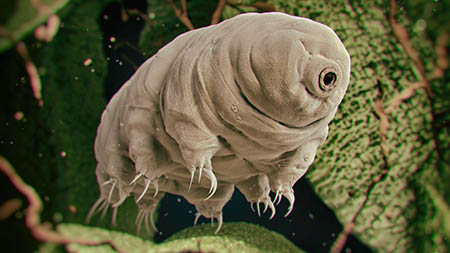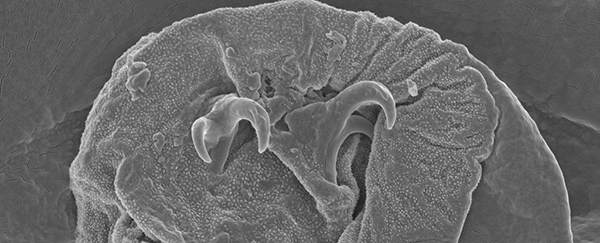

Tardigrades known colloquially as water bears or moss piglets, are a phylum of water-dwelling eight-legged segmented micro-animals.They were first described by the German zoologist Johann August Ephraim Goeze in 1773, who called them little water bears. In 1777, the Italian biologist Lazzaro Spallanzani named them Tardigrada, which means "slow steppers".
They have been found everywhere, from mountaintops to the deep sea and mud volcanoes, and from tropical rainforests to the Antarctic.Tardigrades are among the most resilient animals known, with individual species able to survive extreme conditions - such as exposure to extreme temperatures, extreme pressures (both high and low), air deprivation, radiation, dehydration, and starvation - that would quickly kill most other known forms of life. Tardigrades have survived exposure to outer space. About 1,150 known species form the phylum Tardigrada, a part of the superphylum Ecdysozoa. The group includes fossils dating from 530 million years ago, in the Cambrian period.
Tardigrades are usually about 0.5 mm (0.02 in) long when fully grown. They are short and plump, with four pairs of legs, each ending in claws (usually four to eight) or sucking disks. Tardigrades are prevalent in mosses and lichens and feed on plant cells, algae, and small invertebrates. When collected, they may be viewed under a low-power microscope, making them accessible to students and amateur scientists.
Tardigrades have survived all five mass extinctions. This has given them a plethora of survival characteristics, including the ability to survive situations that would be fatal to almost all other animals .
The lifespan of tardigrades ranges from 3-4 months for some species, up to 2 years for other species, not counting their time in dormant states.
Tardigrades Have a Genetic Secret, And It Could Boost Human Resilience Science Alert - November 2, 2025

A newly discovered protein from Earth's toughest animal is inspiring breakthrough therapies for cancer and cardiovascular disease. Tardigrades, often called water bears or moss piglets, are microscopic creatures that can survive just about anything: boiling heat, freezing cold, and crushing pressure. In fact, tardigrades are the only known animal to survive in outer space. They can also endure radiation levels up to 2,000 times higher than what human cells can tolerate. Naturally, scientists have long wondered: How do they do it?
Microplastics Seem to Be in Every Kind of Animal Except Tardigrades Science Alert - September 23, 2024
Scientists Discover How Tardigrades Survive Blasts of Radiation, And It's Weird nbsp; Science Alert - April 17, 2024
Tardigrades are possibly the most indestructible animal on Earth. These microscopic little beasties can take almost anything humans throw at them, and waddle away perfectly intact on their eight stubby little legs. The strategies behind these feats of superheroic survival are multiple, from a damage suppressor protein that literally protects their DNA, to a dehydrated, suspended animation 'tun' state that they can enter when external conditions get untenable. Now, scientists have uncovered a new one. They're able to turn up the dial on damage repair to 11.
Space Accident Means Tardigrades May Have Contaminated The Moon
Could Tardigrades Have Colonized The Moon?Tardigrades have extraordinary survival skills
What happened to the tardigrades that traveled to the moon in 2019? Given their remarkable abilities to survive situations that would kill pretty much any other animal, could they have contaminated the Moon? Worse, might they be able to reproduce and colonize it?
5 Extreme Times Tardigrades Proved Themselves to Be Incredibly Resilient Science Alert - December 24, 2022
Tiny, weirdly adorable creatures called tardigrades are one of the toughest organisms on Earth. Tardigrades, which are perhaps better known as water bears because of their plump bodies, belong to an extremely resilient group of microorganisms that can thrive in harsh environments ill-suited for life. In order to survive, they squeeze water from their bodies and roll into dehydrated balls known as tuns. While in this form, tardigrades can withstand the most extreme environments - even the vacuum of space. As a tun, these microscopic critters can go years without food or water and endure extreme radiation and temperatures.
Scientists Have Literally Unearthed a Whole New Species of Tardigrade in Finland Science Alert - November 19, 2022

Tardigrades are tiny, incredibly tough animals that can withstand a wide range of dangers, including many that would obliterate most other creatures known to science. Different tardigrade species have adapted to specific habitats all over the Earth, from mountains to oceans to ice sheets. Their resilience can also help them survive accidental adventures beyond the safety of their native habitats, which can lead to opportunities. Not only did they find tardigrades, but researchers found a new species. It becomes just the fifth known member of the Macrobiotus pseudohufelandi complex, a small group of tardigrades with adaptations like reduced legs and claws for living underground.
How tardigrades survive freezing temperatures PhysOrg - October 7, 2022
Tardigrades, also called water bears, belong to the family of nematodes. Their gait is reminiscent of that of a bear, but that is the only similarity. The tardigrades, which are barely one millimeter in size, have managed to adapt perfectly to rapidly changing environmental conditions over the course of evolution and can dry out in extreme heat and freeze in cold conditions. They don't die, they fall into a deep sleep'. For a cell organism, freezing or drying out cause different kinds of stress. But tardigrades can survive both heat and cold equally unscathed. They no longer show any obvious signs of life. And this raises the question of what happens to the animals' internal clock and whether they age in this resting state.
We Just Found Another Trick Tardigrades Use to Be Basically Indestructible Science Alert - October 16, 2020
The world's most indestructible critter just got even more indestructible. Not content with its existing abilities to survive extreme temperatures, pressures, and the airless vacuum of space, the humble yet seemingly unkillable tardigrade looks to have unlocked another amazing superpower: the ability to withstand lethal doses of ultraviolet (UV) radiation. While we have observed tardigrades surviving radiation before now thanks to a 'damage suppression' protein called Dsup, this UV resistance trick is a newly identified feather in the tardigrade's cap, operating via a different kind of biological mechanism.
High temperatures due to global warming will be dramatic even for tardigrades Science Daily - January 16, 2020
A research group has just shown that tardigrades are very vulnerable to long-term high temperature exposures. The tiny animals, in their desiccated state, are best known for their extraordinary tolerance to extreme environments.
Adorable Tardigrades Have a Surprising, Fatal Weakness Live Science - January 16, 2020
Tardigrades are well-loved among science enthusiasts for their oddly adorable appearance. They have plump bodies and four sets of stubby legs. This cuteness has earned tardigrades the nicknames "water bears" and "moss piglets." Most species measure less than 0.02 inches (0.5 millimeters) in length.
They're also survivors. Tardigrades can handle being frozen, dried out, deprived of oxygen and blasted with radiation - they've even survived trips into the vacuum of space. The critters do this by going into what's called a "tun" state. They draw in their limbs and contract their bodies, suspending their metabolism and essentially entering a state of suspended animation. There may even be tardigrades in this tun state on the moon right now, after a crash landing by an Israeli lunar probe likely sent some specimens scattering. Previous research found that tardigrades could even survive being boiled at up to 303.8 F (151 C) for an hour. But no one had studied how tardigrades handle heat for longer periods.
Tardigrades: We're now polluting the moon with near indestructible little creatures PhysOrg - August 10, 2019
An Israeli spacecraft called Beresheet almost made it to the moon in April. It took a selfie with the lunar surface in the background, but then lost contact with Earth and presumably crashed onto the lunar surface. Now it's been revealed that the mission was carrying a cargo of dehydrated microscopic lifeforms known as tardigrades.
Thousands of Tardigrades Stranded on the Moon After Lunar Lander Crash Live Science - August 7, 2019
When you look up at the moon, there may now be a few thousand water bears looking back at you. The Israeli spacecraft Beresheet crashed into the moon during a failed landing attempt on April 11. In doing so, it may have strewn the lunar surface with thousands of dehydrated tardigrades.